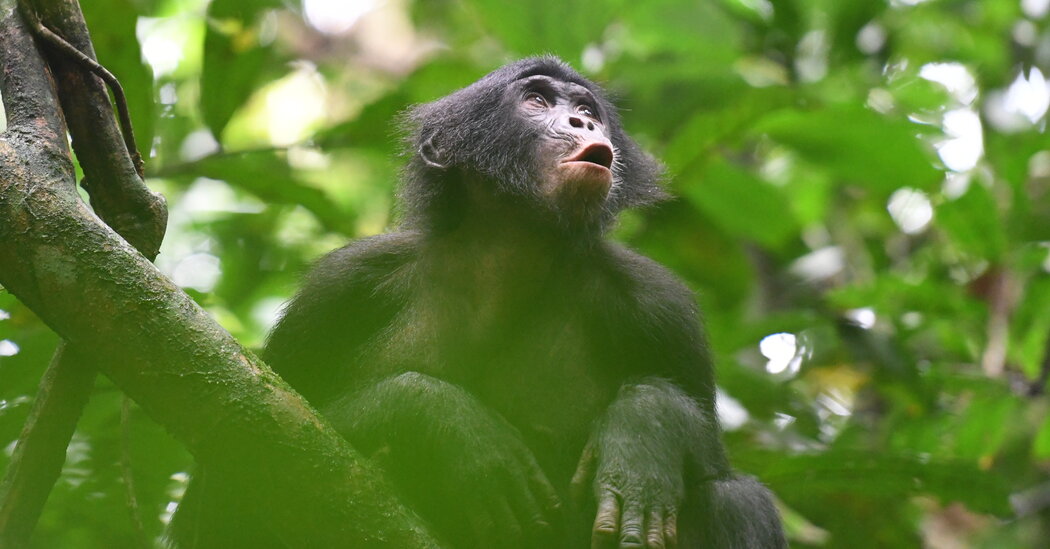
Later being attentive to loads of hours of ape cries, a workforce of scientists say they’ve detected an indicator of human language: the power to construct yarns of sounds to manufacture unused meanings.
The provocative discovering, printed Thursday within the magazine Science, drew proclaim from some students and skepticism from others.
Federica Amici, a primatologist on the College of Leipzig in Germany, mentioned that the learn about helped park the roots of language even additional again in occasion, to hundreds of thousands of years prior to the emergence of our species. “Differences between humans and other primates, including in communication, are far less distinct and well-defined than we have long assumed,” Dr. Amici mentioned.
However alternative researchers mentioned that the learn about, which have been performed on bonobos, related family of chimpanzees, had negligible to expose about how we utility phrases. “The present findings don’t tell us anything about the evolution of language,” mentioned Johan Bolhuis, a neurobiologist at Utrecht College within the Netherlands.
Many species can be in contact with sounds. But if an animal makes a pitch, it generally approach only one factor. Monkeys, for example, can construct one threat name in connection with a leopard and a distinct one for an incoming eagle gliding.
By contrast, we people can yarn phrases in combination in ways in which mix their person meanings into one thing unused. Think I say, “I am a bad dancer.” Once I mix the phrases “bad” and “dancer,” I now not ruthless them independently; I’m no longer pronouncing, “I am a bad person who also happens to dance.” Rather, I ruthless that I don’t dance smartly.
Linguists name this compositionality, and feature lengthy thought to be it an crucial factor of language. “It’s the force behind language’s creativity and productivity,” mentioned Simon Townsend, a comparative psychologist on the College of Zurich in Switzerland. “Theoretically, you can come up with any phrase that has never been uttered before.”
For many years, scientists discovered negative sunlit signal of compositionality in alternative species. However a couple of years in the past Dr. Townsend and his colleagues came upon a touch of it in chimpanzees.
In a Ugandan jungle, Dr. Townsend’s workforce recorded greater than 330 hours of chimpanzees going about their day-to-day lives, and known a bundle distinct cries. To the untrained ear, the recordings may pitch like a random cacophony. However Dr. Townsend and his colleagues spotted that sure cries adopted others greater than can be anticipated by way of probability isolated. All informed, they known 15 unique pairs of cries.
The scientists questioned if a couple of cries carried a that means more than that of 2 person cries on their very own. To check that speculation, they spent two years finding out one pair particularly: a decision referred to as “waa-bark,” adopted by way of every other referred to as “alarm-huu.”
Chimpanzees construct the waa-bark name as some way in order alternative chimpanzees to them. An ape will construct the decision throughout a hunt, for example, or to summon allies throughout a struggle. They construct the alarm-huu name when worried or shocked — based on an earthquake, most likely, or the surprising perceptible of a scientist’s raincoat.
Dr. Townsend and his colleagues questioned if “alarm-huu” when it used to be adopted by way of “waa-bark” intended one thing else. They spotted two events during which a chimpanzee paired the cries when it encountered a snake generation alternative chimpanzees have been inside earshot. In all probability, the scientists idea, the 2 cries in combination intended one thing like, “Get over here and help me deal with this snake!”
Experiments adopted. In a single, the researchers pulled a faux snake throughout a path as chimpanzees handed by way of. The apes, as predicted, frequently answered with “alarm-huu” adopted by way of “waa-bark.”
The researchers later performed the pair of cries via loudspeakers and watched how chimpanzees reacted. The apes tended to have a look at the loudspeaker for a protracted occasion; virtually a negligible. If it performed handiest “alarm-huu” or “waa-bark” on their very own, the chimpanzees glanced over for only a few seconds.
An backup clue instructed that the 2 cries mixed to method a snake alarm: When some chimpanzees heard the paired cries, they leaped right into a tree, an ordinary reaction (amongst apes) when snakes are round.
As mischievous as those concepts have been, trying out them used to be gradual going. To develop the analysis, and pace it alongside, Dr. Townsend started taking part with Martin Surbeck, a behavioral ecologist at Harvard who research bonobos, a species of ape that crack off from chimpanzees two million years in the past. Dr. Surbeck and his colleagues have spent years following apes within the Kokolopori Bonobo Stock within the Democratic Republic of Congo.
In 2022, Melissa Berthet, a postdoctoral researcher in Dr. Townsend’s lab, joined with them to pay attention to the apes. She made 400 hours of recordings, shooting 567 unmarried cries and 425 pairs. Dr. Berthet additionally made a notice of what had took place simply prior to the bonobos made their cries. Did a tree fall? Used to be the ape creating a nest for the night time, or grooming a pal? Dr. Berthet crammed out a 336-item tick list for each and every name.
Shane Steinert-Threlkeld, a computational linguist on the College of Washington who used to be no longer concerned within the learn about, mentioned that the size of the gathered information used to be unrivaled on this order of study. “For that reason, I’m very excited about it,” he mentioned.
Again in Zurich, Dr. Berthet listened to the recordings and categorised the cries right into a bundle differing types. To investigate the that means of the cries, she analyzed her tick list. She and her colleagues later worn probably the most mathematical tactics that synthetic perception methods like ChatGPT utility to be informed how phrases are alike to each and every alternative. This research allowed the scientists to map the bonobo cries visually; the nearer the cries seemed to each and every alternative at the map, the extra matching their meanings.
The researchers additionally discovered that the bonobos steadily hired 16 explicit pairs of cries, and that almost all pairs confirmed up at the map in the similar community as the 2 person sounds comprising them. This instructed that their mixture conveyed negative particular that means.
However 4 pairs of cries stood out. Those landed at the map a ways from the position in their two person cries; in combination, it appeared, they carried a that means not like both name isolated. One such pair, for example, mixed two cries: a top hoot, typically made when a bonobo is making an attempt to attract the eye of others a ways away, and a low hoot, made when the bonobo is occupied with some emotion.
Blended, the 2 cries appear to specific one thing extra, most likely a rescue plea to detached bonobos when beneath assault. “It would be like, ‘Pay attention to me because I am in distress,’” Dr. Berthet mentioned.
Dr. Berthet mentioned that the unused effects will have to deal with any skepticism about Dr. Townsend’s previous learn about on chimpanzees. “Linguists would always say, ‘Yeah, OK, but it’s just one combination — what does it really tell us?’” she mentioned. “Here we show actually bonobos have several compositional structures, and they use them a lot.”
In combination, the 2 research on bonobos and chimpanzees counsel that our regular ancestor with those apes additionally possessed compositionality, the researchers argue.
However Dr. Bolhuis puzzled whether or not the unused learn about may in fact come across compositionality in bonobos. “Compositionality is not just about combining two words,” he mentioned: It’s additionally about following regulations of syntax to form phrases into words and larger devices of that means.
Dr. Townsend countered that most likely the work of pairing cries used to be a primary step towards a full-blown compositionality that had emerged nearest, in early people.
A later step, Dr. Steinert-Threlkeld mentioned, can be for researchers to investigate the bonobo information with extra refined modes, to look if those effects retain up. Possibly a pc might be skilled to be informed the meanings of person cries, later examined to look if it would are expecting the meanings of pairs of cries had by no means heard prior to.
“It’s imperfect,” he mentioned of the unused learn about. “But it’s a good first step.”














